By Charles Morgan and Hubert Walker for CoinWeek ……….
We continue our guide to the Ultimate 20th Century Type Set by taking a look at the 20th century’s workhorse denomination, the quarter. If you haven’t done it yet, be sure to check out parts one and two of our guide, which focus on cents, nickels and dimes.Our selections may surprise you.
In this installment, we hope to illuminate some of the tough buying choices a demanding collector will have in assembling the ultimate type set.Even if you aren’t in the market for top-end material or conditional rarity, you might learn something of value in building the type of collection that suits your needs.
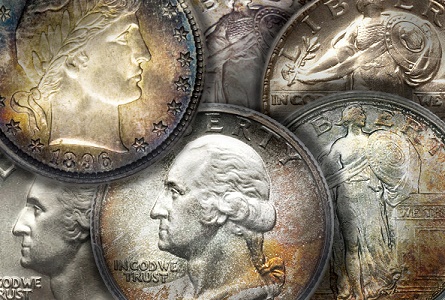 So let’s proceed and see how 20th Century quarter dollars shape up.
So let’s proceed and see how 20th Century quarter dollars shape up.
Barber Quarter (1901-1916)
The Scenario: For the first sixteen years of the 20th century, Charles Barber and his designs dominated America’s silver coinage. The Barber dime, quarter, and half dollar all met their demise, however, when Congress approved a change in the design of each of these denominations in 1916. The series has experienced its share of ebbs and flows in the marketplace, but it’s remarkably stable and getting more expensive as the years go by.
 For the Ultimate Set, the 20th century Barber quarter offers two show-stopping choices.
For the Ultimate Set, the 20th century Barber quarter offers two show-stopping choices.
Guidance: Were one to consider mintage numbers only, the 1913-S and its 40,000 struck pieces would far and away prove to be the most elusive of the Barber quarters. The inexplicable first year issue 1916 Standing Liberty quarter has a mintage of just 12,000 more, but the 1901-S Barber, and its initial mintage of 72,664 has almost entirely been lost to time. By PCGS’s estimates 2,000 remain[1]. In terms of gradable material, that number may prove to be generous.
The best known example, a beautifully-preserved toned specimen graded MS-68+ by PCGS, fetched $327,750 at Bowers & Merena’s March 2010 auction in Baltimore. PCGS and NGC population reports for the issue are likely grossly overstated due to resubmissions. What would an Ultimate 20th Century Set be without the ultimate 20th century rarity?
[1] http://www.pcgscoinfacts.com/Coin/Detail/5630. Accessed 1/23/14.
Standing Liberty Quarter Type 1 (1916-1917)
The Scenario: Owning the distinction of being the most beautiful quarter dollar ever struck, Massachusetts-born Hermon Atkins MacNeil’s Standing Liberty Quarter debuted at the height of Theodore Roosevelt’s artistically infused golden age of American coin design. The subject of the coin, borrowed from the Beaux-Arts movement, is a bare-breasted personification of Liberty, whose left arm holds aloft a shield of defense while she extends an olive branch of peace with her right hand. The reverse features an elegant depiction of an eagle in flight.
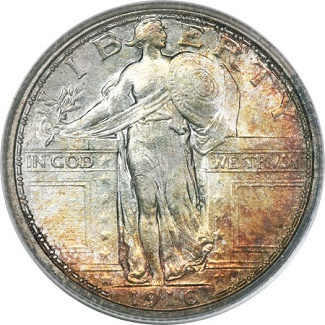 52,000 pieces (the result of a few days’ work) were struck in late December 1916. These, like the 1856 Flying Eagle cent struck 60 years earlier, were quietly entered into circulation, where they became highly sought after by collectors, dealers, and speculators. It’s estimated that 20% of the total mintage survives, but fewer than 1500 likely exist in Mint State. The combination of its scarcity, the fact that it’s a first year issue, and the amusingly controversial appearance of a bare breast (and, in better struck examples, even finer detail) add to the coin’s lasting appeal.
52,000 pieces (the result of a few days’ work) were struck in late December 1916. These, like the 1856 Flying Eagle cent struck 60 years earlier, were quietly entered into circulation, where they became highly sought after by collectors, dealers, and speculators. It’s estimated that 20% of the total mintage survives, but fewer than 1500 likely exist in Mint State. The combination of its scarcity, the fact that it’s a first year issue, and the amusingly controversial appearance of a bare breast (and, in better struck examples, even finer detail) add to the coin’s lasting appeal.
Guidance: All of these reasons make the 1916 quarter the must-have Type Coin for our Ultimate Set. A modest premium exists for Full Head examples. This isn’t due to any added scarcity as most struck up well, but due to demand for full strikes. We find the head detail important, but would add – and not in a tongue-in-cheek fashion – that finding fully struck breasts with full detail is actually harder than finding a coin with a well-struck head. Be that as it may, a premium fully-struck example in MS-65 will set you back $30,000. In MS-63? About $20,000. By way of comparison, the much more common 1917 costs roughly $900 in Gem.
Standing Liberty Quarter Type 2a (1917-1924)
The Scenario: Liberty’s bare breasts were covered in chain mail, supposedly having something to do with a ginned-up controversy on the part of religious fundamentalists. The design lost much of its grandeur in the needless revision and certainly suffered technically as the new version struck up considerably worse than the original.
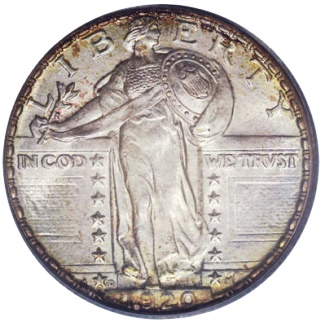 Guidance: As with the Type 1, the Type 2a (a slight revision to the obverse in 1925 gets the moniker Type 2b) includes an issue that serves as a stopper for most collectors. That release is the ultra-rare 1918/7-S.
Guidance: As with the Type 1, the Type 2a (a slight revision to the obverse in 1925 gets the moniker Type 2b) includes an issue that serves as a stopper for most collectors. That release is the ultra-rare 1918/7-S.
With but a handful of Full Head examples (top pop PCGS MS-64+) and fewer than 200 known examples in Mint State, the release is one of the 20th century’s most coveted silver issues. The 8/7 over-date wasn’t discovered until some twenty years after the coin’s production, which meant that the overwhelming majority of them had already entered into circulation. Mere luck accounts for the few Mint State survivors that remain–nearly all pulled from dealer stock or collector inventory
Only the Full Head 1927-S approaches the price and scarcity of the 1918/7-S.
Standing Liberty Quarter Type 2b (1925-1930)
The Scenario: To better protect the date from the wear it was susceptible to in circulation, the Mint changed the obverse design in 1925. For the final six years of production, Standing Liberty quarters were struck with slightly recessed dates, which did protect the feature from wear but didn’t totally alleviate the problem.
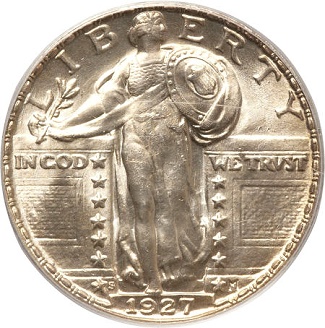 And while this later period of Standing Liberty quarter production yielded some of the series’ more common issues, it also produced a handful of scarcities.
And while this later period of Standing Liberty quarter production yielded some of the series’ more common issues, it also produced a handful of scarcities.
Guidance: The holy grail of Standing Liberty quarter rarities is the Full Head 1927-S. It’s open to debate which one truly is rarer: the 52,000 struck 1916 Type 1 or the 396,000 struck 1927-S. We cautiously believe fewer examples of the latter remain. Because of this, the coin is remarkably expensive.
Grades MS-65 and above will set you back one new Lamborghini Gallardo. A choice MS-63 example? A mere Lexus. With fewer than 20 possible examples certified by PCGS, this is clearly a 20th century rarity that comes around only once every couple of years.
While we like other scarce Full Head strikes–especially the trinity of Denver rarities: the 1926-D, 1928-D, and 1929-D–we return to the 1927-S as the best choice for our set. Even if you don’t go for a Full Head example, a Nearly-Full Head or heretofore-unattributed Full Head specimen in any of the Gem grades will be available at a fraction of the cost and offer tremendous upside. In 2011, Heritage sold a lightly toned, CAC-certified example in MS-65 for $13,225. That piece probably won’t “upgrade” to Full Head, but there are coins that are marginal in this respect that are worth hunting down.
The second reason we like this issue is its combination low mintage and ultimate scarcity. The Standing Liberty quarter is a difficult, expensive, and underrated series that has a finite number of extant quality pieces in several issues and an equally finite number of collectors that can afford them. Cherry pick the best date and the best coin and you will have your ultimate type set piece. For us there’s no question, a quality 1927-S is the way to go.
Washington Quarter – Silver (1932-1964)
The Scenario: What was intended to be a one-year circulating commemorative became one of many long-running presidential portrait issues that capped the Modern Era of United States coinage. Flanagan’s Washington quarter, despite its many famous detractors, evokes a timelessness that perfectly suits our nations’ first and most important President. The quarter denomination lied dormant the year before and the year after the coin’s debut in 1932. Production resumed in 1934, while the Mint undertook a handful of minor design changes meant to strengthen the motto IN GOD WE TRUST. Though there are presumed to be no absolute rarities in the series, the silver period does contain a number of interesting and expensive numismatic delicacies.
 Guidance: It almost goes without saying that the 1932-D is the king of the Washington quarter series.
Guidance: It almost goes without saying that the 1932-D is the king of the Washington quarter series.
For a short period of time, the ’32-D ran a close second to the ‘32-S. The latter had a slightly lower mintage and based on this it was first believed to be the scarcer of the two issues. However, when the dust settled, it was apparent to dealers and collectors that the ’32-D, in mint state, was considerably more difficult to acquire than the lower mintage ’32-S.
How did this view fair in the era of Third Party grading? Well, the chart below, while showing only “instances” of the grading of coins (multiple instances can represent the same coin), shows a real disparity between the ’32-D and ’32-S…especially in grades above MS-63, but in MS-65 and above, both coins are true conditional rarities.

Gems for both issues are exceptionally scarce. In MS-64 and below, demand and legacy considerations drive market value.
Today, the price of the ’32-S is softer than one would assume based on scarcity, and both issues experience some downward price drag as both are easy to find in circulated grades. At the top end of the grading spectrum, the sole MS-66 1932-D, an obverse rainbow toned / reverse 95% brilliant piece (cert #4260522), sold at a Heritage auction in 2001 for $89,125 and, according to PCGS’ CoinFacts, again through Bowers & Merena in 2008 for $143,750. Four 1932-S quarters have been certified MS-66 by PCGS, the most recent to sell at auction being a beautiful pale gold and lavender CAC-certified example that brought $35,250 at a Heritage auction in January 2013.
In the silver Washington quarter period, no coin competes with the 1932-D at MS-66, but a few options exist for the adventurous collector at MS-65
The first is the 1943 FS-103, commonly referred to as the 1943 Doubled Die Obverse. This coin shows significant doubling in LIBERTY and IN GOD WE TRUST. PCGS reports a population of 25 in Mint State. However, their erroneous pricing data obscures the true value of the issue. We believe it to be $12,000 in MS-65, $20,000 in MS-66, and $35,000 to $50,000 in MS-67 (pop 1). These figures are merely estimates.
An even more pronounced doubled die is the 1937 DDO (FS-101), which is a naked-eye visible, dramatically doubled coin that actually has fewer Mint State examples reported than the 1943, but is generally believed to be slightly less scarce. A CAC-certified PCGS MS-66 with a pale silvery-gold patina sold by Heritage in January 2013 brought $21,150.
In our opinion, the Ultimate Type Set collector would choose among one of these four options to fill the silver Washington quarter hole. We like the ultimate scarcity concept, and would take one of the high end doubled dies over the 1932-D, but an eye popping example of any of the four will always impress a collector and bring an impressive sum in the marketplace.
Washington Quarter – Clad (1965-1998)
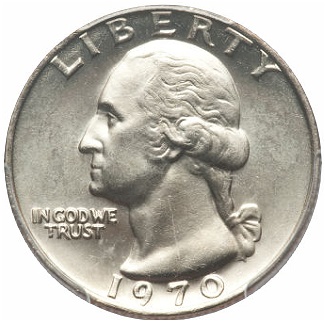 The Scenario: The line of demarcation for many collectors, who are adverse to pursuing modern and post-modern coinage, is 1964, the year of the date freeze and composition change, when the United States abandoned the controversial 90% silver alloy as a circulating medium once and for all.
The Scenario: The line of demarcation for many collectors, who are adverse to pursuing modern and post-modern coinage, is 1964, the year of the date freeze and composition change, when the United States abandoned the controversial 90% silver alloy as a circulating medium once and for all.
Saying that differences between the old and new coining metals created a host of technical challenges for the Mint’s engraving and die shops is an understatement. While we’ve all seen more than our share of 1965 and later clad quarters, few recall many examples, especially in the early years, that evoke numismatic majesty. Several do exist, and the market for them, while nowhere approaching red hot, is developing and should continue to prove profitable for those who know where to look and how to trade in this material.
Guidance: We’ve written about clad Washington quarters before. And our guidance then was that the 1969 quarter, more than any other clad-period quarter struck since 1965, is the true collector coin of the series. Not only has the overwhelming majority of the issue been put into circulation, but the numbers of pristine 1969 mint sets is dwindling. Contrary to popular belief, we will live in a time when 1960s and ‘70s U.S. Mint Uncirculated Sets will be hard to come by, especially undamaged ones. And even these sets contain but a paltry few MS-65 candidate 1969 quarters.
The Philadelphia Mint’s production quality in the late ‘60s through the end of the ‘70s was demonstrably poorer than that of the Denver Mint, and practically everything that could go wrong with the 1969 quarter did. In MS-66, the coin is undervalued at about $300. In MS-66+, the coin brings between $450 and $600, while a true MS-67 should bring $4,000 and above. Personally, we’d hoard this issue in high grades.
Washington Quarter – State Quarter Series (1999-2008)
Finally, we come to the State Quarter series (1999-2008; 2009 if you’re like us and grandfather the Territory and District of Columbia quarters into the series). The market today for conditionally rare State Quarters is surprisingly thin. So much so that there’s very little money to be made by searching for premium quality pieces in the raw and submitting them for grading (even in bulk). Will this always be the case? There’s no guarantee of course, but for the foreseeable future, probably.
We like the idea of cherry picking and storing PQ examples in 2×2 flips. The coins can be found on the cheap–mostly at or slightly above face value–and while there’s no shortage of nice coins, truly stunning examples for many issues aren’t as prevalent as one might assume. Still, unless you are looking at a surefire MS-68 or better, you’re better off keeping your coins tucked away in the raw.
While we are by no means bullish on State quarters as a series, we do feel that a strong exception needs to be made for attractive, naturally toned coins in the series. Clad coinage generally tones up in a range of mostly yellow hues. When you get pieces that display vibrant and attractive multi-colored toning, you’ve got something that will find a willing buyer at a significant premium. It’s possible that hundreds of thousands of State quarters will eventually tone up, so this might not be the stablest market, and the price per piece is and will be highly variable and largely dependent on eye appeal and grade. But still, you might get lucky and get a $100 offer on a MS-65 Connecticut that would have lingered on eBay for months were it not for the added color.
So, while State quarters might not be your thing, a complete set of colorful natural toners will certainly appeal to a growing number of collectors. Keep that in mind when you’re perusing the wares on the bourse floor.
Our guide through the Ultimate 20th Century Type Set continues next month, when we take on halves and silver dollars.
Flip of a Coin:
- Sometimes, collecting coin ephemera is almost as cool as the coin itself. Charles recently had the good fortune of picking up a Norweb 14 (a common variety) of the 1856 Slanted 5 large cent in MS-63 from a reputable national dealer. The coin was exceptionally nice for the grade and reasonably priced, but what really made it stand out was the inclusion of a small brown envelope that read, in part: “Lot 350” A. Kosoff. P.O. Box 456 – Encino, California. Abe Kosoff was a leading national dealer, who got his start in 1929. That this piece retains that personal touch is one of the quintessential pleasures this hobby has to offer.
- MacNeil’s original design for the Standing Liberty quarter featured dolphins at Liberty’s feet. Interestingly, the design was completed at the time of the completion of the Panama Canal. The dolphin motif did end up on another United States coin: the highly coveted 1915 Pan-Pac commemorative $50 slug.
- We like to keep abreast of new coin legislation in Congress, especially proposals for new commemorative coins. The 112th Congress had commemorative fever…and the 113th looks to be closing the gap. Three new bills have been introduced recently: H.R. 3680 (the Breast Cancer Awareness Commemorative Coin Act), H.R. 3729 (the Korean Immigration Commemorative Coin Act…again), and H.R. 3867 (the Purple Heart Hall of Honor Commemorative Coin Act)
© 2014 Charles Morgan and Hubert Walker
About the Authors: Charles Morgan is a member of the American Numismatic Association, the American Numismatic Society, the Numismatic Literary Guild, and the Richmond Coin Club. Together with his co-author Hubert Walker (ANA, NLG), he has written numerous articles for publication online and in print, including two 2013 NLG award-winning articles for CoinWeek.com.





You are missing the 1976 Bicentennial quarter in the type set. Any state quarter struck after the year 2000 is in the 21st Century and do not belong in a 20th Century type set since each state quarter is unique in its design unlike the other denominations which spanned two centuries.